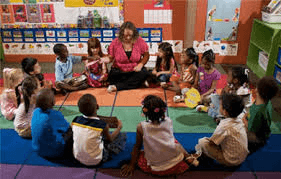ACTIVE LISTENING STRATEGIES FOR CHILDREN
For Increasing Concentration and Self Control
There’s nothing that breaks down human communication more than when the ears go on vacation and the mouth keeps working overtime. We have two ears, two eyes and only one mouth because we learn so much more about each other and our world by listening and observing.
One of the most important strategies we can offer the young children we work with is to help them learn to listen more mindfully. Attentive, conscious listening can help relax the mind, nervous system and muscles which will increase the child’s ability to focus and concentrate.
Listening leads to concentration, and concentration is what children need to do in order to learn difficult things. Physical activity, music and speech programs are three of the most effective strategies for promoting listening and concentration skills. Listening is an active process, and my research and teaching experiences have led me to discover a variety of effective strategies to use with young children.
First of all, you can help children put on their “Thinking Caps” by having them massage their earlobes from top to bottom several times a day. This is a Brain Gym® activity that stimulates the nerve endings in the earlobes for improved listening abilities. I have discovered that a child will hear everything I say when they are doing this activity as I speak to them.
As a motor development specialist, I train young children to be able to perceive beat and rhythm in music and life. Therefore, it is very important for me to help them develop their listening skills step by step. I have discovered an effective procedure for helping children to not just hear, but also mindfully experience the sounds they hear with their whole body and mind, thereby developing more finely tuned self control.
When introducing music and movement activities to children, I have found it most effective to introduce them through the following progressive sequence of sounds and commands. By following this sequence, the children are not overwhelmed with too many sounds at one time which can over-stimulate their listening system and make it difficult for them from to discern beat and rhythm.
1. Voice only
2. Sound of one instrument
3. Sound of instrument and voice
4. Instrumental music
5. Instrumental music with singing
For example, when teaching children to walk in rhythm it is best to start off by simply repeating the following phrases:
“Walk, walk, let’s go for a walk, walk let’s go for a walk – stop”
“Let’s walk slowly, slowly, slowly, let’s walk slowly, slowly - stop”
“Let’s walk faster, faster, faster, let’s walk faster, faster – stop”
Then have them walk to the beat of a drum or hand clapping. Then use your voice and the drum beat together. When children can hear and move to fast and slow tempos and follow the beat, you can introduce more complex sounds with multiple instruments and singing.
It is the simple progressive steps that provide the consistent successes and challenges that prevent frustration, confusion or the excess stimulation that can hinder or halt their progress. All great musicians, dancers, athletes and performers learned and mastered their crafts by practicing and acquiring their skills one step at a time.
For information on Scott’s Funsical audio CD’s, curriculum materials and training programs please visit www.funsical.com or call 303-902-4985. As a valued customer of SafeGard Classes Online you are entitled to free shipping by entering the Coupon Code – Free Shipping
© Scott Liebler 2017
Scott Liebler has been researching, teaching and developing early childhood development programs for thirty years. He is the creator of Funsical – www.funsical.com - a curriculum of music, movement and language activities that appeal to children’s natural desire to move and have fun while developing essential skills. He is the author of Safegard Classes On Line - Music, Movement and Language early childhood courses and How to Take a Chill Pill stress management class. He has served as an adjunct faculty member for Front Range Community College in Denver, CO, a seminar presenter for the Bureau of Education and Research (BER) and administers the Move to Improve program for early childhood communities. For information on Funsical audio CD’s, curriculum materials and training programs please visit www.funsical.com or call 303-902-4985
